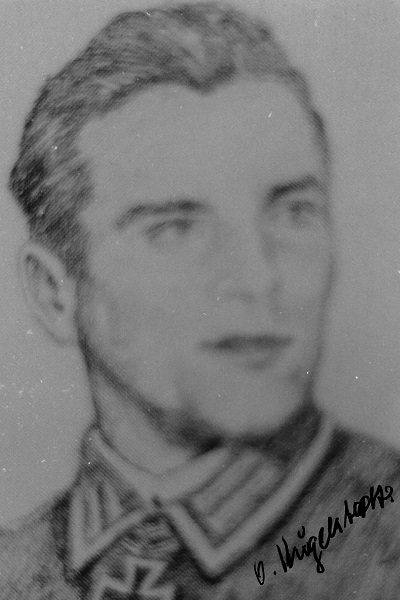Kugelstadt, Otto (Grenadier-Regiment 485)
- Date of birth:
- January 17th, 1920 (Orlen/Hesse, Germany)
- Date of death:
- October 10th, 2000 (Taunusstein-Neuhof/Hesse, Duitsland)
- Nationality:
- German
Biography
Do you have more information about this person? Inform us!
- Period:
- Second World War (1939-1945)
- Period:
- Second World War (1939-1945)
- Period:
- Second World War (1939-1945)
- Rank:
- Feldwebel (Staff Sergeant)
- Unit:
- Zugführer, 6. Kompanie, II. Bataillon, Grenadier-Regiment 485, 263. Infanterie-Division, Heer
- Awarded on:
- December 26th, 1944
“In the area of Heeresgruppe Kurland the 263. Infanterie-Division was stationed 35 km southeast of Libau. On the 15.11.1944 Feldwebel Kugelstadt and 35 men were positioned in the forward line. They formed the I. Zug of the 6. Kompanie and were tasked with holding a 600 metre long section of frontline near Sepeni. This sector was also the one immediately adjacent to the neighbouring division (30. Infanterie-Division).
Just after they had a chance to become familiar with the terrain the Second Battle of Courland began in the morning hours of the 19.11.1944. The soldiers experienced one of their heaviest artillery barrages seen thus far, with the fire being particularly heavy on the all-important Hill 191.6. Here the enemy planned to begin their breakthrough to the German supply port of Libau.
Hill 191.6, which lay at the boundary between the two divisions, was lost and with it the connection between the two units. Only in the afternoon was the situation made clear and it was revealed that the enemy had broken through the neighbouring division. All communications links had been severed.
Meanwhile the troops of the 263. Infanterie-Division, and in particular Grenadier-Regiment 485, were holding their positions with tolerable losses. Acting on his own initiative, Kugelstadt and his Zug attacked Hill 191.6 and took it back. Kugelstadt then organized the sectors for his squads and formed a Kampfgruppe to secure the threatened flank.
On the next day the enemy forces moved again, but failed to break through the German defences at the ‘Elephant Lake’ and the Hill 191.6. The Germans also held the line the day after. But in the morning hours of the 22.11.1944, the 4th day of the battle, Kugelstadt was forced to cede the hill and pull back with his men to Sepeni. However, in a bold coup-de-main, he recaptured the hill and held it for the next two days and nights.
But Kugelstadt’s men could not withstand the 14th attack on the 24.11.1944. Nevertheless they had broken the attacking power of the enemy on this hill. The neighbouring division was also able to seal off or shrink the enemy penetrations.
By now the losses of the Zug amounted to 1 dead and 24 wounded. Thus a Feldwebel and 10 men remained to carry out their duties. On the 25.11.1944 a replacement squad with an Unteroffizier and 11 men reached the Zug. However while Kugelstadt was instructing the new squad leader, an AT round hit a nearby tree. Apart from the driver all the new men were injured. 3 of them died before dawn. So Kugelstadt and his small group had to tough it out by themselves. They had to endure the constant threat of enemy snipers positioned on Hill 191.6 by day and turn into true lone fighters at night. Nonetheless they withstood 2 more attacks.
On the morning of the 26.11.1944, due to the losses sustained the previous night, the Zug was down to 1 Feldwebel and 6 men, who took shelter in an earthen bunker. Only one guard stood as watch outside of it. Weapons at the ready, every soldier had fallen asleep due to total exhaustion. Just 80 metres behind them was the forward observer of the I. Abteilung of the Division’s artillery regiment, Leutnant Friedmann, who knew he was the one on who the infantry had placed their hopes.
Shortly afterwards the enemy artillery opened up again, this time with captured German rocket artillery. 3 such rounds struck near the earthen bunker, throwing the whole structure and its garrison onto a slope nearby. After a few seconds, the 7 slightly injured soldiers crawled out of the wreckage and jumped unarmed into the depression where their bunker used to be, waiting for the attacking enemy. Kugelstadt then shot with his remaining flare gun between the attacking Russians, red-white-green. This was the signal for the forward observer to fire on the Germans’ own positions. Thus the entire Artillerie-Regiment 263 opened fire.
The 6 men of the I. Zug pressed themselves against the trench walls and awaited their end. But, after a barrage by their own artillery lasting 10 minutes, there was deathly silence. The Second Battle of Courland was over.”





